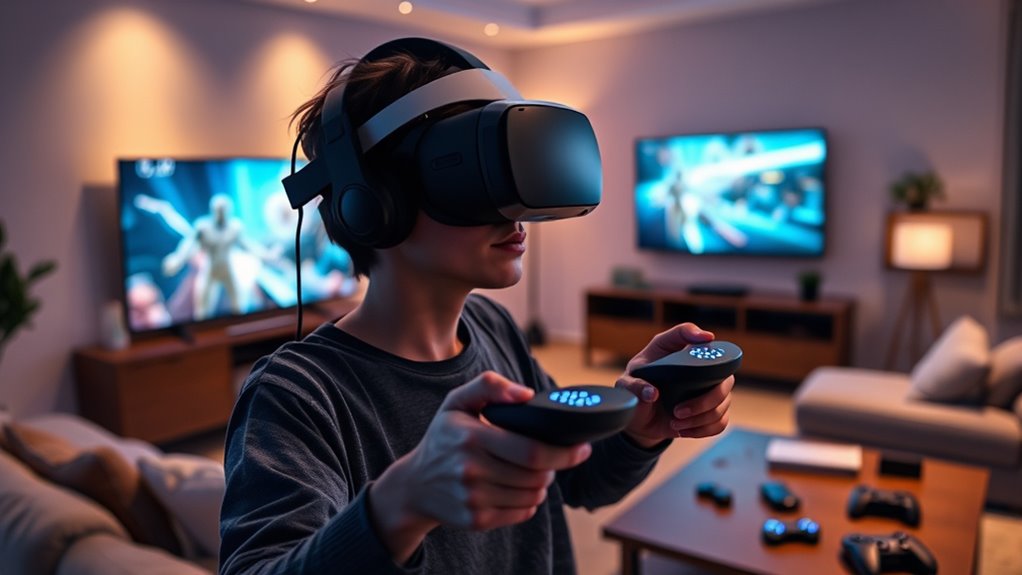Today’s VR headsets let you enjoy a wide range of consumer applications. You can immerse yourself in immersive gaming experiences, exploring fantasy worlds or racing through futuristic cities. Virtual exploration allows you to visit landmarks and discover new places without leaving home. Social apps offer virtual hangouts with friends, while fitness programs make exercise more engaging. As technology keeps improving, you’ll see even more realistic and inclusive virtual environments—stay tuned to discover what’s coming next.
Key Takeaways
- VR headsets are widely used for immersive gaming, offering realistic environments and lifelike interactions.
- They enable virtual exploration of landmarks, historical sites, and natural wonders for educational purposes.
- Consumers use VR for social experiences, such as virtual gatherings and online social platforms.
- Fitness applications turn workouts into engaging, immersive activities, promoting health and wellness.
- VR technology supports diverse applications, including training, virtual tours, entertainment, and cultural experiences.

Virtual reality headsets have become more accessible and advanced than ever before, transforming how you experience digital content. With these devices, you’re no longer limited to watching screens; instead, you’re immersed directly within the digital environment. This leap forward has revolutionized consumer use-cases, especially in immersive gaming and virtual exploration. When you put on a VR headset, you step into a world that responds to your movements, making gameplay more engaging and lifelike. Whether you’re battling foes in a fantasy domain or racing through futuristic cities, VR makes the experience feel authentic and visceral. The sense of presence is so strong that it’s easy to forget you’re in your living room. It’s this level of immersion that keeps gamers hooked, offering a new dimension of entertainment that traditional screens can’t match.
Beyond gaming, virtual exploration is another popular use-case that appeals to your curiosity and sense of adventure. With VR headsets, you can visit far-off landmarks, explore ancient ruins, or walk through a bustling city—all from your own home. VR apps and experiences have grown increasingly sophisticated, providing detailed environments that respond naturally to your gaze and movements. Traveling to a remote location or touring a famous museum becomes accessible without the need for travel expenses or physical effort. This form of virtual exploration is especially valuable in education, where it allows you to interact with historical sites or natural wonders in a way that feels real. It opens up possibilities for learning and discovery that were previously limited by geography or cost. Additionally, understanding the importance of Cultural Intelligence can help developers create more culturally sensitive and inclusive virtual experiences, enriching the overall user engagement.
The convenience and versatility of modern VR headsets mean you can switch between immersive gaming and virtual exploration seamlessly. Many devices support a wide range of applications, from social VR platforms where you can hang out with friends in a virtual lounge, to fitness apps that turn exercise into an engaging experience. The hardware itself continues to improve, offering higher resolutions, broader fields of view, and more comfortable designs. As a result, you’re encouraged to spend more time exploring different content types, making VR a versatile tool for entertainment, education, and even social interaction. The technology’s rapid evolution means that your virtual experiences will only become more realistic and compelling, blurring the lines between digital and real worlds.
Frequently Asked Questions
How Do VR Headsets Impact Mental Health Over Prolonged Use?
Prolonged use of VR headsets can affect your mental health by causing cybersickness side effects like nausea and dizziness. It might also impact your mood and sense of reality due to prolonged immersion impacts, leading to feelings of disconnection or anxiety. To minimize these effects, take regular breaks, limit your VR sessions, and pay attention to how your body reacts. Staying mindful helps you enjoy VR safely without compromising your mental well-being.
What Are the Most Affordable VR Headsets for Beginners?
If you’re looking for affordable options, the Oculus Quest 2 is a great choice. It offers beginner-friendly features like easy setup, wireless freedom, and a comfortable fit. Another budget-friendly option is the PlayStation VR, especially if you already own a PlayStation. Both headsets provide immersive experiences without breaking the bank, making them perfect for newcomers wanting to explore VR without a big investment.
How Do VR Headsets Ensure User Privacy and Data Security?
VR headsets address privacy concerns by implementing robust data encryption, protecting your personal information during use. They often require permissions for tracking and data collection, which you can control through settings. Manufacturers also update firmware regularly to fix security vulnerabilities. To stay secure, always review privacy policies, disable unnecessary tracking features, and keep your headset’s software up to date, ensuring your data remains protected while enjoying immersive experiences.
Can VR Headsets Be Used Effectively for Remote Work?
Using a VR headset for remote work is like stepping into a virtual office, making virtual collaboration and immersive meetings feel natural. You can interact with colleagues as if you’re in the same room, enhancing communication. VR headsets enable effective remote work by offering real-time collaboration tools, shared virtual spaces, and interactive presentations. This technology transforms distant teams into connected ones, boosting productivity and engagement in ways traditional video calls can’t match.
What Are the Latest Advancements in VR Headset Hardware Technology?
You’ll notice the latest VR headset advancements include improved hardware like haptic feedback, which offers realistic touch sensations, and eye tracking for more natural interactions. These innovations enhance immersion and responsiveness, making your experiences more lifelike. Manufacturers are also refining display resolution and reducing latency, so your movements feel seamless. Staying updated on these tech improvements helps you get the most out of your VR adventures, whether for gaming, work, or socializing.
Conclusion
In today’s world, VR headsets deliver diverse dreams—from daring adventures to daily discoveries. As you immerse yourself in digital domains, embrace the evolving experience, exploring entertainment, education, and more. With every new headset, you’re stepping into a space where technology transforms your tasks and thrills. So, seize the scene, stay savvy, and savor the spectacular, swift shifts in virtual reality—your journey into the future is just a headset away.









